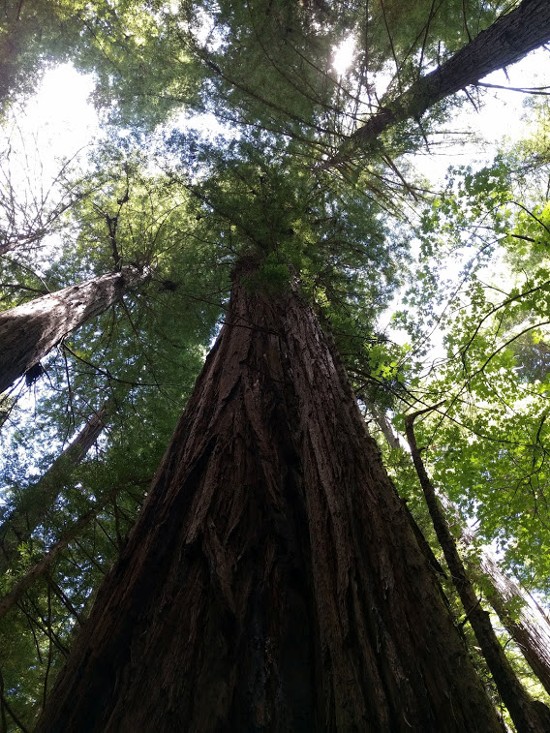May 30, 2020 – The world’s forests are changing and the cause is anthropogenic climate change. It’s not just the rising temperatures and carbon dioxide (CO2) levels in the atmosphere, but also land-use changes, wildfires, droughts, and biological attacks from insects, fungi, and non-native vines like Kudzu which can choke forests. Although increased CO2 levels is a stimulus to tree growth, the co-occurrence of negative forces is creating changes to forest dynamics. The negative forces are expected to increase as the century unfolds.
Last summer my wife and I traveled through Northern California’s redwood forests, some of the most majestic living plants ever to grow on Earth. Standing at the foot of one of these behemoths was inspiring. But little did we know at the time that the tree you see below is one of the many under threat not from logging but from changes happening to the local environment that have planetwide implications.

A study published yesterday in the journal Science describes the present state of deforestation that is killing the older and taller and leaving us with the younger and shorter trees. We are also witnessing a decline in the number of forests, expected to continue throughout the century. What this means for the Earth is a decline in biodiversity because larger trees support more than less, and a reduction in the capacity of the world’s second-largest natural carbon sink. global forests.
In Western North America and Europe, forests are in decline with tree deaths having doubled since 1980. Add to this deforestation from harvesting forests which has reduced cover by 12% since 1900. And forests containing trees 140 years old or greater have decreased from 89 to 66%. The death of older trees releases more carbon into the atmosphere than can be removed by young trees. This is particularly true for tropical rainforests, among the most species-rich tree communities on the planet.
Studies of even relatively undisturbed areas of the Amazon are showing higher rates of tree mortality even in the face of increased CO2 in the atmosphere. That would seem to be counterintuitive since plants breathe in CO2. But it is not the trees that appear to be the beneficiaries. Rather it is other vegetation such as climbing woody vines that have enjoyed growth with the attendant problem these pose for trees.
Monica Turner, a forest ecologist at the University of Wisconsin, in an article appearing in National Geographic this week summarizes what the world will experience as the century continues. “We will see fewer forests. There will be areas where there are forests now where there won’t be in the future.”
Our Earth today is home to 60,000 species of trees. Having experienced the Redwoods of California, the Douglas Fir of the British Columbia coast, and the forest canopy that surrounds the apartment where I live here in Toronto, it is hard to envision a world with fewer trees. It will be far poorer with less biodiversity, and each fall when the leaves of the deciduous trees that change colour from greens to reds, and golds, those who follow us may not experience the joy and beauty of that seasonal rite of passage.








